
This article first appeared in the journal Exhibition (Fall 2023) Vol. 42 No. 2 and is reproduced with permission. If you don’t read the journal, learn how you can subscribe to Exhibition to receive your copy of the full upcoming issues.
It is Monday morning at First Americans Museum (FAM), and a group of fifth graders are bustling with excitement as they embark on a gallery tour. A museum educator welcomes the students in her native language and emphasizes the uniqueness of a museum led by tribal citizens. Her first-person use of “we,” “our,” and “us” when describing First American stories, cultural materials, and values is reflected in the exhibition’s interpretive texts. Rich colors and thoughtfully selected design motifs enliven each gallery space, creating a warm and safe environment for the group as they attend to the interpretive media and objects on view (intro image). A student pulls the educator aside to show her a Woodlands bandolier bag—“something that comes from [my] tribe!”—and asks her to read the Potawatomi language title on the object label.
The staff of FAM are among many museum professionals seeking to disrupt the wonder cabinet[1] and white cube[2] methods of presentation still endemic among collections of Indigenous cultural materials. These conventional models—whether richly ornamented in dark oak and brass or minimalistic with stark white walls—may feel nostalgic or elevated to some, but can make an otherwise thoughtful and compelling exhibition feel downright hostile for many more, namely the descendants of people brutalized by the British, other European, and American empires.
This article will illustrate how exhibition designers are influenced by the colonial imagination, a term we use for the settler mythology behind imperial ambition, both historical and contemporary. Employed intentionally or not, these design choices undermine efforts to create an inclusive sense of welcome for both staff and visitors. To address this, we focus on three areas of exhibition design and development as possible sites of decolonization: look and feel, narrative, and visitor experience. In each of these areas we offer examples of how the colonial imagination influences exhibition design, strategies for noticing when we are veering into colonial choices, and ideas for interrupting those impulses in order to make our museum spaces more welcoming and equitable for visitors. We, the authors, offer our unique perspectives: Adrienne Lalli Hills, citizen of Wyandotte Nation, brings her expertise as an exhibition developer and learning professional; Margaret Middleton, a white settler, brings their expertise as an exhibition designer focused on inclusive museum practice. What would it look like to design exhibition spaces that not only tolerate but prioritize the desires and expressions of the people whose cultures are in the collections? Together, we hope to activate your imagination beyond the limits of the colonial construct.
Look and Feel
One of the goals of the FAM curatorial team was to create exhibition environments steeped in Indigenous creativity, values, and aesthetic systems—a stark departure from design conventions that often feel colonial. An exhibition’s ambient look and feel is expressed through color palette and material choices, as well as graphic design and sound quality. These elements are often decided upon at the start of the design process. If exhibition developers are careful to look for colonial tendencies in the earliest mood board and sample palette, we can shift the design direction before a colonial aesthetic has the chance to become embedded.
The most egregious example of colonial aesthetics in exhibition design is the wonder cabinet model, characterized by arrays of decontextualized objects in oak cases arranged in neat taxonomies. When encapsulated behind the glass panes of the wonder cabinet, cultural materials are reduced to amusing curios, and natural-history specimens become illustrations of inborn hierarchies and progress over time. Victoriana more broadly, with its glass terrariums, velvet curtains with gold Orientalist tassels, and phrenology models, evokes late-1800s England when the British Empire was ramping up its violent colonial efforts around the world. The aesthetics of Victoriana are rooted in expeditions and obsessions that exoticize non-Western cultures. The theme of “discovering” the mysterious other also comes through in freight cargo aesthetics, in which exhibit elements are displayed in faux crates, sometimes complete with stamps and objects nestled in packing material. While evocative, this choice treats cultural materials as commodities and capitalizes on the colonial thrill of importing treasures from far away. Exhibitions that indulge in nostalgic colonial kitsch may be particularly tricky to identify at the moment because of the aesthetic’s recent resurgence in popular interior design trends, specifically with a renewed interest in velvet upholstery, tropical houseplants, and maximalism.
Even if a gallery space does not reference the aesthetics of the wonder cabinet or a Victorian-inspired salon, a colonial feel can be communicated through color and material choices. For example, exhibitions about Indigenous art or history frequently employ somber earth tones, painting First American people with one buckskin-colored brush. Not only does this inaccurately portray the vibrant color enjoyed by First American artists past and present, earth tones also equate Indigenous people with the natural world, while neutrals create overly reverent moods that evoke the “noble savage,” prioritizing the preferences and expectations of non-Indigenous visitors over dismantling stereotypes and creating resonance among Indigenous visitors. Similarly, subtle material choices—such as the irregular and unfinished pedestals created by Austrian artist Franz West for the Arts of the Pacific galleries at the Los Angeles County Museum of Art (LACMA)—position cultures as primitive and, in the case of Pacific Islander communities, evoke violent histories of European and Japanese occupation (fig. 1). This installation, led by a non-Indigenous artist, otherwise employed the framing of white cube minimalism, an approach often conflated with neutrality. Compare LACMA’s restrained, yet culturally essentialist, exhibition furniture with the richly colored cases at FAM that reject conventional wisdom of how an exhibition of Indigenous art should look. Like maximalism, minimalism has also seen a recent resurgence in popularity, so be aware, too, of the implications of following this interior design trend.
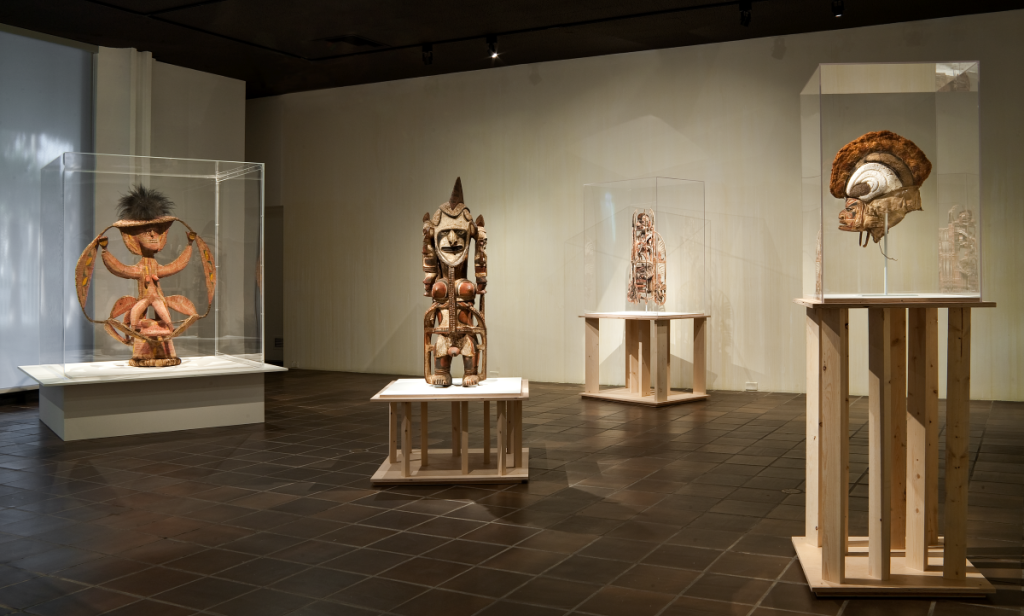
Colonial aesthetics also appear in exhibition graphic design in the form of typeface choices, patterns, and symbols. Some fonts have been identified as perpetuating racism: for example, Neuland, which designer Rob Giampietro describes as “stereotypography.”[3] This font, originally developed for circus broadsheets, continues to be used in publishing for African American and First American authors and subjects. Similarly, as Cherokee Nation scholar and artist Roy Boney, Jr. notes, Papyrus, a font frequently used for Egyptian, Mesopotamian, and First American subjects, “paints [First Americans] as noble mystic savages while forcing us to continually live as relics of the past.… It belittles our standing as vibrant, 21st-century people with strong cultures.”[4] These trends in popular graphic design also frequently turn up in exhibition design. Graphic designers use patterns and symbols for visual interest, drawing inspiration from the exhibition’s subject. If employed thoughtfully, this can lend depth and authenticity, but if a designer does not share the cultural experience and expertise of the people who developed these elements and uses them superficially, they may unintentionally communicate that the meanings behind the appropriated visual motifs are unimportant and, thereby, that the culture that created them is equally unimportant.[5] Though designers pride themselves on their adaptability, all designers are not equally suited to any given project. “There are certain situations where we cannot begin to identify with the lived experiences of the audience we need to communicate with,” writes designer Anoushka Khandwala. “It’s in these moments that we need to take ourselves out of the equation as the creative.”[6] Designers who are culturally connected to their exhibits’ subjects are more likely to successfully avoid stereotypes and create spaces that exude a spirit of welcome.
Aesthetics are also shaped by sound quality. When galleries are designed exclusively for quiet contemplation and silence is enforced by guards and docents, museums prioritize the comfort and culture of white, wealthy visitors over all others. Cultural critic Xochitl Gonzalez describes silence as the sound of gentrification.[7] Background sound, however, should be selected with cultural intention. Regarding the process for selecting music for a FAM exhibition, cultural musicologist John Hamilton (Kiowa/Caddo/ Cheyenne/Wichita) writes: “All genres of music have a spirit to them that makes everyone move, dance, and connect spiritually, and the WINIKO objects are no different.”[8] To culturally connected museum practitioners like Hamilton, the selection of music is as much about the material and spiritual care of objects as it is about supporting the visitor experience.
Narratives
Visitors bring with them an “entrance narrative,” a set of preconceived notions informed by centuries of inherited biases and misconceptions about the past. Researchers have demonstrated how visitors seek information in exhibitions that reinforces this durable narrative that wall text and design choices alone cannot remediate.[9] In the context of First American exhibitions, even well-intentioned efforts to establish empathy between the presumably non-Indigenous visitor and Indigenous subject can perpetuate cultural bias.[10] With this in mind, it becomes even more critical for museums to consider the narratives—including organization and language choices—that underpin exhibitions. Consistent engagement with community members and scholars from the cultures exhibited is essential, from the earliest part of the exhibition-development process and throughout all planning phases. Indeed, today, giving communities “full authority” to represent themselves is becoming the norm.[11]
Neat taxonomies describing cultures or classifying objects must be disrupted by acknowledging ambiguity and multiple ways of knowing. Similarly, linear timelines, a fixture in history exhibitions, are often inadequate to express the reciprocal and dynamic relationships among people, events, and ideas and reinforce Western or nationalistic notions of progress.[12] Maps, too, present reductive cultural associations by geography, emphasizing Western concepts of land ownership and, in static presentations, fail to show the global engagement and dynamic movement of Indigenous nations.[13] Designers must, therefore, critically consider how the conceptual and physical layout of an exhibition may confirm or disrupt biased thinking—rather than defaulting to exhibition organization by chronology, geography, or other externally applied categories. Museums can engage visitors in these internal considerations. For example, Lalli Hills and colleagues at the Nelson-Atkins Museum of Art illuminated for visitors the artificial boundaries among collecting areas and art historical scholarship using a flowchart wall graphic (fig. 2).
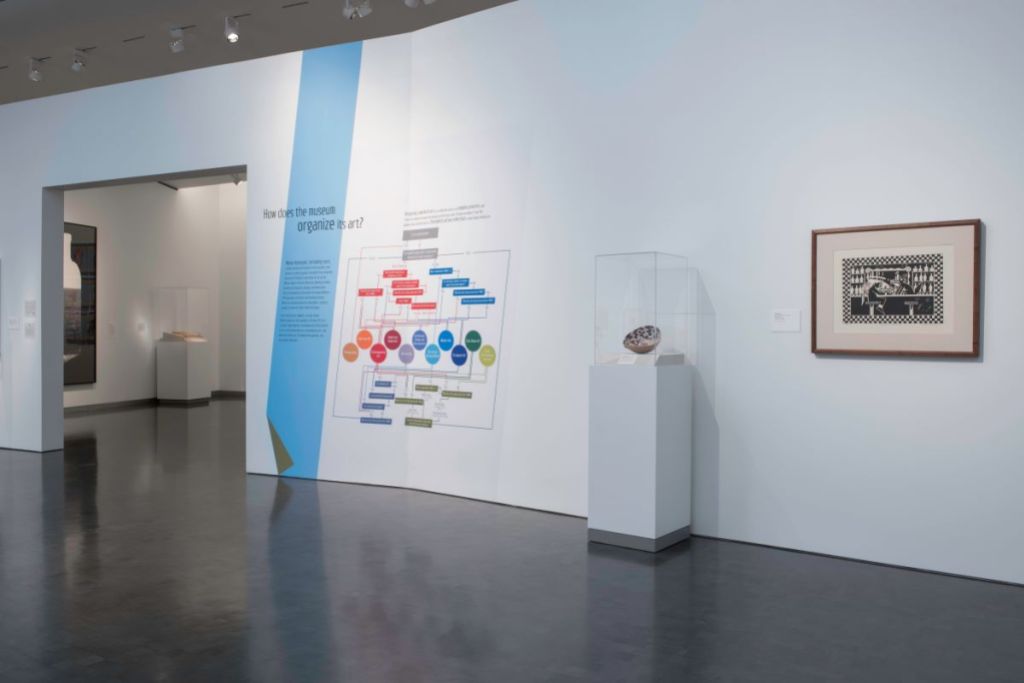
When writing exhibition text, consider whose voices are most prominent. An anonymous, “omniscient” institutional voice may cast non-Western subjects as “other,” while uncritical use of “our,” “us,” and “we” can confuse visitors and flatten diverse cultures into a monolith.[14] The thoughtful use of attributed voices through quotations and audiovisual content can enliven the visitor experience and reinforce the continued presence of cultures.
The colonial imagination is animated by word choices that exoticize the subject (“ancient,” “mysterious,” or “prehistoric”), and the colonial fixation on authenticity is evident through repeated expressions of connoisseurship (“exquisite,” “exceptional,” or “rare”) and the dismissal of the value of customary materials made for sale. Indigenous innovations are often not recognized for the scientific and technological achievements they are; robust economic activity is often described as provincial trade. Further, an overreliance on or default to the past tense in interpretive text suspends cultures in amber and denies continuance of cultural knowledge, practices, and values. Engage co-authors or editors from the communities reflected in exhibition content to avoid these pitfalls.
Visitor Experience
Exhibition makers must also consider their intentions, both explicit and implicit, for how visitors will conduct themselves in the museum. The colonial imagination guides visitor behavior through invitations to “explore” and expectations to “behave.” Decolonial practice, however, shifts visitor modes away from the experiences and preferences of whiteness and empire.
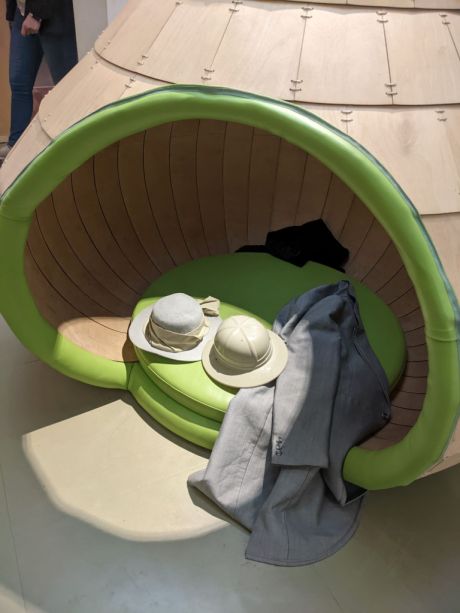
Visitors are often invited to play a role in gallery activities: through “decoding” games with pictographs, interactives like mock archaeological digs, and prompts to imagine themselves as explorers uncovering mysteries. Though some exhibit developers may think child-size khaki uniforms and pith helmets are a cute way to engage children in natural history or archaeology galleries, for many, these outfits bring to mind the fetishistic and violent obsessions of European Victorians, including Egyptomania and the African safari (fig. 3). Urging visitors, especially children, to take on the role of colonial explorer through costuming or, more subtly, through invitations in label copy to “explore” and “discover” is an insidious way we exhibition makers unwittingly make visitors our accomplices in reifying colonial dynamics. Exhibition developers could instead take a cue from Indigenous game designers who resist colonial tropes with novel game mechanics such as cooperative play and complicating binary “us vs. them” narratives.[15] It is also imperative to work with communities to develop activities that invite respectful inquiry without activating colonial dynamics. At FAM, exhibition interactives place Native voices in charge of the activity and narrative: riders in a “powwow van” travel Indian Country with a chatty Kiowa narrator as they visit cultural celebrations and dances. Tribal sovereignty and continued presence in Oklahoma are demonstrated as visitors try to match bean bags printed with political names of nations to their associated location on a monumental map of the state (fig. 4).
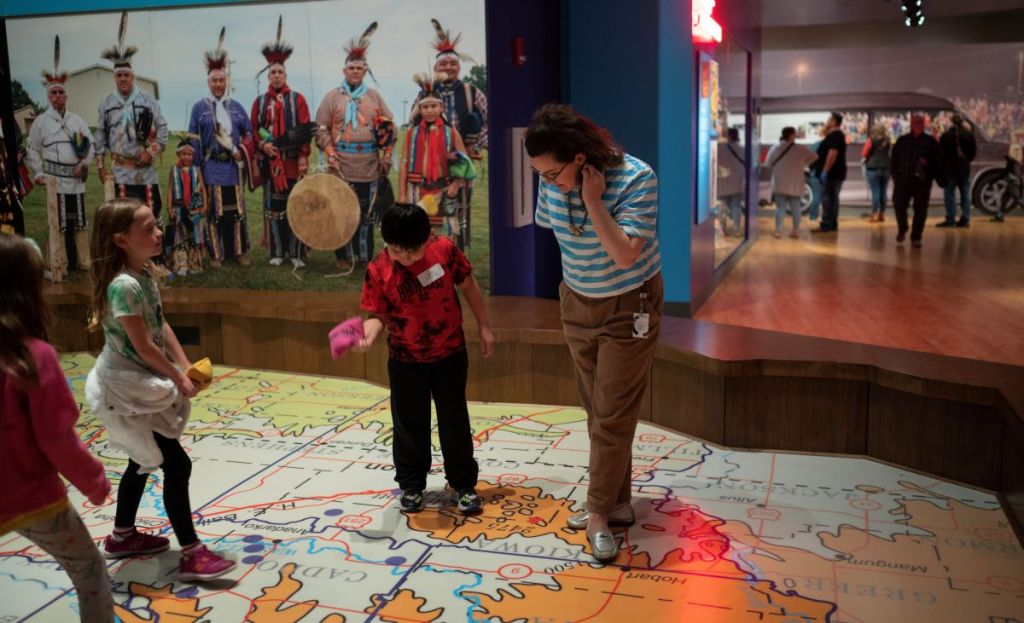
Visitors are also often expected to play the role of the “good museum visitor,” code for the white, wealthy visitor. Just this year incidents in American museums have made headlines: an Indigenous artist was told to remove the traditional woven baby carrier she was wearing in an exhibition of baskets by Indigenous artists;[16] a Black artist was told to leave an exhibition about Black Rest after asking white visitors to respect the space;[17] and a Cambodian artist was asked to leave a museum for performing a dance prayer to her ancestral gods in a gallery of stolen religious statues.[18] As activist group Decolonize This Place says museums “want the art, not the people.”[19] Museums benefit immensely from the artistry and thought of Black and Indigenous cultures. Rethinking expectations for visitor behavior can help museums demonstrate that they value Black and Indigenous presence not only in the form of silent objects behind glass but as people in the gallery.
Call to Action
Ultimately, practitioners should resist exhibition concepts inextricably bound with colonialism, especially when these present no significant shift in scholarship or contain no significant critical perspectives or counternarratives. Museums must reconsider platforming well-trod subjects, such as Impressionist Japonisme or Edward Curtis photographs, simply because they are “canonical” and will guarantee significant audience interest.
Together with colleagues in every department, exhibit designers and developers must upend the institutional systems and assumptions that reinforce colonial ideas in exhibits. In addition to the recommendations in this article, consider revisiting annual budgets to provide resources for decolonial initiatives, such as retaining paid cultural advisors or updating label copy. Identify ways in which your institution can demonstrate reciprocity to communities through collaboration or sharing of resources. Create a new framework for evaluating upcoming exhibitions that prioritizes the selection of non-Western cultures and critical perspectives. Document these initiatives so that present efforts are sustained and built upon rather than becoming make-work projects upended by turnover.
We close with an invitation to our fellow practitioners: reframe decolonizing work not as a limitation but as a generative dialogue among museums, communities, histories, and futures. Decolonizing exhibit design can lead to liberatory experiences that present our world as more complex, intricate, and wondrous than colonial perspectives could ever have imagined.
[1] Ken Arnold, Cabinets for the Curious: Looking Back at Early English Museums (Aldershot, UK: Ashgate, 2006).
[2] Brian O’Doherty, Inside the White Cube: The Ideology of the Gallery Space (San Francisco: The Lapis Press, 1986), available at: https://arts.berkeley.edu/wp-content/uploads/2016/01/arc-of-life-ODoherty_Brian_Inside_the_White_Cube_The_Ideology_of_the_Gallery_Space.pdf.
[3] Rob Giampietro, “New Black Face: Neuland and Lithos as Stereotypography,” Letterspace (Journal of the Type Directors Club) (2003): https://linedandunlined.com/archive/new-black-face/.
[4] Roy Boney, Jr., “Papyrus: The Power of a Bad Font,” First American Art Magazine, February 20, 2015, https://firstamericanartmagazine.com/papyrus-bad-fonts/.
[5] “Think Before You Appropriate: Things to Know and Questions to Ask in Order to Avoid Misappropriating Indigenous Cultural Heritage,” IPinch. Intellectual Property Issues in Cultural Heritage: Theory, Practice, Policy, Ethics (Vancouver: Simon Fraser University, 2015), https://www.sfu.ca/ipinch/sites/default/files/resources/teaching_resources/think_before_you_appropriate_jan_2016.pdf.
[6] Anoushka Khandwala, “What Does It Mean to Decolonize Design?” AIGA Eye on Design, June 5, 2019, https://eyeondesign.aiga.org/what-does-it-mean-to-decolonize-design.
[7] Xochitl Gonzalez, “Why Do Rich People Love Quiet?” The Atlantic, August 1, 2022, https://www.theatlantic.com/magazine/archive/2022/09/let-brooklyn-be-loud/670600/.
[8] John Hamilton, email message to Adrienne Lalli Hills, March 21, 2023.
[9] Adrienne Lalli Hills, “Counterpoint: Whose Harm?” blog post, Association for Art Museum Interpretation, February 15, 2023, https://artmuseuminterp.org/2023/02/15/counterpoint-whose-harm/.
[10] Zahava D. Doering and Andrew J. Pekarik, “Questioning the Entrance Narrative,” The Journal of Museum Education 21, no. 3 (1996): 20–23, http://www.jstor.org/stable/40479072; and Nancy Marie Mithlo and Aleksandra Sherman, “Perspective‐Taking Can Lead to Increased Bias: A Call for ‘Less Certain’ Positions in American Indian Contexts,” Curator: The Museum Journal 63, no. 3 (July 2020): 353–69, https://doi.org/10.1111/cura.12373.
[11] James Pepper Henry, “First Americans Museum: Creating an Indigenous Institution,” OKLA HOMMA (2021).
[12] Steven Lubar, “Timelines in Exhibitions,” Curator: The Museum Journal 56, no. 2 (April 2013): 169–88, https://doi.org/10.1111/cura.12018.
[13] Aaron Glass and Jolene Rickard, “Met Roundtables: Boundaries in Native America,” lecture, Metropolitan Museum of Art, February 1, 2019, New York City, New York, video (1:16:13), https://www.youtube.com/watch?v=holkwjuh9Oc.
[14] C.D. Green, “A Major Museum’s Attempt to Center Native American Voices,” SAPIENS, December 8, 2022, https://www.sapiens.org/culture/field-museum-native-voices/.
[15] Mary Flanagan and Mikael Jakobsson, Playing Oppression: The Legacy of Conquest and Empire in Colonialist Board Games, (Cambridge, MA: The MIT Press, 2023), 152.
[16] Rhea Nayyar, “Museum Apologizes for Asking Native Mother to Remove Traditional Baby Carrier,” Hyperallergic, March 14, 2023, https://hyperallergic.com/808028/museum-apologizes-for-asking-native-mother-to-remove-traditional-baby-carrier/.
[17] Taylor Michael, “Museum Apologizes for Kicking Out Black Artist From Installation,” Hyperallergic, March 29, 2023, https://hyperallergic.com/811266/moma-apologizes-for-kicking-out-black-artist-from-installation/.
[18] Sophiline Cheam-Shapiro, “Met Museum Kicked Me Out for Praying to My Ancestral Gods,” Opinion, Hyperallergic, March 21, 2023, https://hyperallergic.com/809442/met-museum-kicked-me-out-for-praying-to-my-ancestral-gods/.
[19] “Brooklyn Museum,” paraphrasing poet Jayne Cortez, Decolonize This Place, accessed July 11, 2023, https://decolonizethisplace.org/.




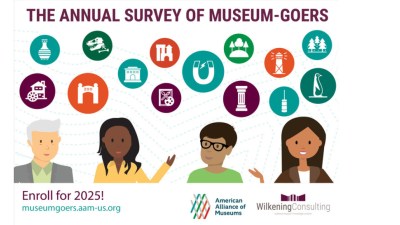



Comments